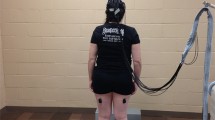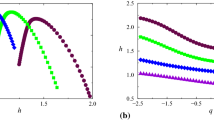Abstract
Discrete wavelet analysis is used to resolve the center of pressure time series data into several timescale components, providing new insights into postural control. Healthy young and elderly participants stood quietly with their eyes open or closed and either performed a secondary task or stood quietly. Without vision, both younger and older participants had reduced energy in the long timescales, supporting the concept that vision is used to control low frequency postural sway. Furthermore, energy was increased at timescales corresponding to closed-loop (somatosensory and vestibular) and open-loop mechanisms, consistent with the idea of a shift from visual control to other control mechanisms. However, a relatively greater increase was observed for older adults. With a secondary task a similar pattern was observed—increased energy at the short and moderate timescales, decreased energy at long timescales. The possibility of a common strategy—at the timescale level—in response to postural perturbations is considered.








Similar content being viewed by others
References
Addison P (2002) The illustrated wavelet transform handbook: introductory theory and applications in science, engineering, medicine and finance. CRC Press, New York
Bertrand P, Bardet JM, Dabonneville M, Mouzat A, Vaslin P (2001) Automatic determination of the different control mechanisms in upright position by a wavelet method. In: 23rd annual international conference of the IEEE Engineering in Medicine and Biology Society. IEEE, Istanbul, Turkey, pp 1163–1166
Blaszczyk JW, Orawiec R, Duda-Kiodowska D, Opala G (2007) Assessment of postural instability in patients with Parkinson’s disease. Exp Brain Res 183:107–114
Carello C, Turvey MT, Kugler PN (1985) The informational support for upright stance. Behav Brain Sci 8:151–152
Carroll JP, Freedman W (1993) Nonstationary properties of postural sway. J Biomech 26:409–416
Cavanaugh JT, Guskiewicz KM, Stergiou N (2005) A nonlinear dynamic approach for evaluating postural control—new directions for the management of sport-related cerebral concussion. Sports Med 35:935–950
Collins JJ, Deluca CJ (1993) Open-loop and closed-loop control of posture—a random-walk analysis of center-of-pressure trajectories. Exp Brain Res 95:308–318
Collins JJ, Deluca CJ (1994) Random walking during quiet standing. Phys Rev Lett 73:764–767
Collins JJ, Deluca CJ (1995) The effects of visual input on open-loop and closed-loop postural control mechanisms. Exp Brain Res 103:151–163
Collins JJ, Deluca CJ, Burrows A, Lipsitz LA (1995) Age-related-changes in open-loop and closed-loop postural control mechanisms. Exp Brain Res 104:480–492
Dault MC, Frank JS (2004) Does practice modify the relationship between postural control and the execution of a secondary task in young and older individuals? Gerontology 50:157–164
Davis JR, Campbell AD, Adkin AL, Carpenter MG (2009) The relationship between fear of falling and human postural control. Gait Posture 29:275–279
Donker SF, Roerdink M, Greven AJ, Beek PJ (2007) Regularity of center-of-pressure trajectories depends on the amount of attention invested in postural control. Exp Brain Res 181:1–11
Duarte M, Zatsiorsky VM (2001) Long-range correlations in human standing. Phys Lett A 283:124–128
Gauchard GC, Jeandel C, Tessier A, Perrin PP (1999) Beneficial effect of proprioceptive physical activities on balance control in elderly human subjects. Neurosci Lett 273:81–84
Gepner B, Mestre DR (2002) Brief report: Postural reactivity to fast visual motion differentiates autistic from children with asperger syndrome. J Autism Dev Disord 32:231–238
Gibson JJ (1979) The ecological approach to visual perception. Houghton Mifflin, Boston, MA
Guerraz M, Bronstein AM (2008) Mechanisms underlying visually induced body sway. Neurosci Lett 443:12–16
Guerraz M, Yardley L, Bertholon P, Pollak L, Rudge P, Gresty MA, Bronstein AM (2001) Visual vertigo: symptom assessment, spatial orientation and postural control. Brain 124:1646–1656
Haddad JM, Van Emmerik REA, Wheat JS, Hamill J (2008) Developmental changes in the dynamical structure of postural sway during a precision fitting task. Exp Brain Res 190:431–441
Horak FB (2004) Postural orientation and equilibrium: what do we need to know about neural control of balance to prevent falls? In: International symposium on preventing falls and fractures in older people. Oxford University Press, Yokohama, pp 7–11
Horak FB, Machpherson JM (1996) Postural orientation and equilibrium. In: Handbook of physiology. Exercise: regulation and integration of multiple systems. Oxford University Press, New York, pp 255–292
Huxhold O, Li SC, Schmiedek F, Lindenberger U (2006) Dual-tasking postural control: aging and the effects of cognitive demand in conjunction with focus of attention. Brain Res Bull 69:294–305
Ivry RB, Spencer RM, Zelaznik HN, Diedrichsen J (2001) The cerebellum and event timing. In: Highstein TM, Thach WT (eds) Conference on recent developments in cerebellar research, St Louis, Missouri, pp 302–317
Kahneman D (1973) Attention and effort. Prentice Hall, Englewood Cliffs
Khandoker AH, Lai DTH, Begg RK, Palaniswami M (2007) Wavelet-based feature extraction for support vector machines for screening balance impairments in the elderly. IEEE Trans Neural Syst Rehabil Eng 15:587–597
Kinsella-Shaw JM, Harrison SJ, Colon-Semenza C, Turvey MT (2006) Effects of visual environment on quiet standing by young and old adults. J Mot Behav 38:251–264
Lackner JR, DiZio P, Jeka J, Horak F, Krebs D, Rabin F (1999) Precision contact of the fingertip reduces postural sway of individuals with bilateral vestibular loss. Exp Brain Res 126:459–466
Ladislao L, Fioretti S (2007) Nonlinear analysis of posturographic data. Med Biol Eng Compu 45:679–688
Laufer Y, Barak Y, Chemel I (2006) Age-related differences in the effect of a perceived threat to stability on postural control. J Gerontol A Biol Sci Med Sci 61:500–504
Misiti M, Misiti Y, Oppenheim G, Jean-Michel P (1996) Wavelet toolbox: for use with MATLAB. The Mathworks Inc., Natick, MA
Morales CJ, Kolaczyk ED (2002) Wavelet-based multifractal analysis of human balance. Ann Biomed Eng 30:588–597
Oppenheim U, Kohen-Raz R, Alex D, Kohen-Raz A, Azarya M (1999) Postural characteristics of diabetic neuropathy. Diabetes Care 22:328–332
Paulus WM, Straube A, Brandt T (1984) Visual stabilization of posture—physiological stimulus characteristics and clinical aspects. Brain 107:1143–1163
Perrin P, Deviterne D, Hugel F, Perrot C (2002) Judo, better than dance, develops sensorimotor adaptabilities involved in balance control. Gait Posture 15:187–194
Peterka RJ (2002) Sensorimotor integration in human postural control. J Neurophysiol 88:1097–1118
Querner V, Krafczyk S, Dieterich M, Brandt T (2000) Patients with somatoform phobic postural vertigo: the more difficult the balance task, the better the balance performance. Neurosci Lett 285:21–24
Rama-Lopez J, Perez N, Vila EM (2004) Dynamic posture assessment in patients with peripheral vestibulopathy. Acta Otolaryngol 124:700–705
Riccio GE (1991) Information in movement variability about the qualitative dynamics of posture and orientation. In: Newell KM, M CD (eds) Conference on variability and motor control. Human Kinetics Publishers, Chicago, IL, pp 317–357
Riccio GE, Stoffregen TA (1988) Affordances as constraints on the control of stance. Hum Mov Sci 7:265–300
Riley MA, Balasubramaniam R, Turvey MT (1999) Recurrence quantification analysis of postural fluctuations. Gait Posture 9:65–78
Roerdink M, De Haart M, Daffertshofer A, Donker SF, Geurts ACH, Beek PJ (2006) Dynamical structure of center-of-pressure trajectories in patients recovering from stroke. Exp Brain Res 174:256–269
Schmit JM, Riley MA, Dalvi A, Sahay A, Shear PK, Shockley KD, Pun RYK (2006) Deterministic center of pressure patterns characterize postural instability in Parkinson’s disease. Exp Brain Res 168:357–367
Schumann T, Redfern MS, Furman JM, Eljaroudi A, Chaparro LF (1995) Time-frequency analysis of postural sway. J Biomech 28:603–607
Shimizu Y, Thurner S, Ehrenberger K (2002) Multifractal spectra as a measure of complexity in human posture. Fractals-Complex Geometry Patterns and Scaling in Nature and Society, vol 10, pp 103-116
Slobounov S, Slobounov E, Sebastianelli W, Cao C, Newell K (2007) Differential rate of recovery in athletes after first and second concussion episodes. Neurosurgery 61:338–344
Spencer RMC, Zelaznik HN, Diedrichsen J, Ivry RB (2003) Disrupted timing of discontinuous but not continuous movements by cerebellar lesions. Science 300:1437–1439
Stelmach GE, Zelaznik HN, Lowe D (1990) The influence of aging and attentional demands on recovery from postural instability. Aging (Milano) 2:155–161
Suarez H, Muse P, Suarez A, Arocena M (1999) Postural behaviour responses to visual stimulation in patients with vestibular disorders. In: Meeting of the Collegium Oto-Rhino-Laryngologicum Amicitae Sacrum (CORLAS). Taylor & Francis As, Lyon, France, pp 168–172
Suarez H, Muse P, Suarez A, Arocena M (2001) Assessment of the risk of fall, related to visual stimulation, in patients with central vestibular disorders. Acta Otolaryngol 121:220–224
Suarez H, Geisinger D, Suarez A, Carrera X, Spiller P, Lapilover V (2007) Postural strategies in normal subjects and in patients with instability due to central nervous system diseases after sudden changes in the visual flow. In: Meeting of the Collegium Oto Rhino Laryngologicum Amicitiae Sacrum. Taylor & Francis As, Seoul, South Korea, pp 398–403
Thurner S, Mittermaier C, Hanel R, Ehrenberger K (2000) Scaling-violation phenomena and fractality in the human posture control systems. Phys Rev E 62:4018–4024
Thurner S, Mittermaier C, Ehrenberger K (2002) Change of complexity patterns in human posture during aging. Audiol Neurootol 7:240–248
Uetake T, Tanaka H, Shindo M, Okada M (2004) Two new methods applicable to center of pressure swing analysis. Anthropol Sci 112:187–193
Vaillancourt DE, Newell KM (2002) Changing complexity in human behavior and physiology through aging and disease. Neurobiol Aging 23:1–11
van Emmerik REA, van Wegen EEH (2002) On the functional aspects of variability in postural control. Exerc Sport Sci Rev 30:177–183
Williams HG, McClenaghan BA, Dickerson J (1997) Spectral characteristics of postural control in elderly individuals. Arch Phys Med Rehabil 78:737–744
Winter DA (1995) A.B.C. (anatomy, biomechanics and control) of balance during standing and walking. University of Waterloo Press, Waterloo, ON
Woollacott M, Velde TJV (2008) Non-visual spatial tasks reveal increased interactions with stance postural control. Brain Res 1208:95–102
Zatsiorsky VM, Duarte M (1999) Instant equilibrium point and its migration in standing tasks: rambling and trembling components of the stabilogram. Motor Control 3:28–38
Zatsiorsky VM, Duarte M (2000) Rambling and trembling in quiet standing. Motor Control 4:185–200
Zatsiorsky VM, King DL (1998) An algorithm for determining gravity line location from posturographic recordings. J Biomech 31:161–164
Zelaznik HN, Spencer RMC, Ivry RB (2008) Behavioral analysis of human movement timing. In: Grondin S (ed) Psychology of time. Bingley, UK, pp 233–260
Zhu X, Kim J, Bhattacharaya A, Bornschein R (2007) Study of the effect of early lead exposure on postural balance by advanced signal processing methods. Int J Biomed Eng Technol 1:86–100
Author information
Authors and Affiliations
Corresponding author
Appendices
Appendix 1: Calculating the energy content of the signal
The energy content at the level “j” can be expressed in terms of the detail WCs at that scale as,
Similarly, the total energy content of the signal can be found by summing the energy content of the approximated signal and the energy content over all J levels of the detail signals:
where the energy at each discrete scale j = 1,…, J and discrete location k = 0,…, K(j) are summed. The energy content of the different scales can be expressed as a percentage of the total energy of the signal which is the sum of the decomposed scale energies
Appendix 2: Energy content percentage for vision effect
The percentage of energy content for the vision effect was examined by comparing the quiet standing with eyes open (SEO) and quiet standing with eyes closed (SEC) conditions for each trial of a subject as,
where E SEO%(j) and E SEC%(j) are the energy content percentages averaged over the three trials for the quiet standing with eyes open and quiet standing with eyes closed conditions, respectively. ∆E EYE%(j),j = 1,…, 3 for one young individual (subject 14) are shown in Fig. 5c.
Appendix 3: Energy content percentage for tapping effect
The percentage of energy content for the tapping effect was examined by comparing the quiet standing with eyes open (SEO) and tapping with eyes open (TEO) conditions for each trial of a subject as
where E SEO%(j) and E TEO%(j) are the energy content percentages averaged over the three trials for the quiet standing with eyes open and tapping with eyes open cases, respectively. The calculation was conducted for each of the young and older subjects.
Rights and permissions
About this article
Cite this article
Chagdes, J.R., Rietdyk, S., Haddad, J.M. et al. Multiple timescales in postural dynamics associated with vision and a secondary task are revealed by wavelet analysis. Exp Brain Res 197, 297–310 (2009). https://doi.org/10.1007/s00221-009-1915-1
Received:
Accepted:
Published:
Issue Date:
DOI: https://doi.org/10.1007/s00221-009-1915-1




